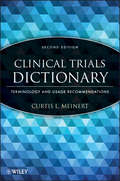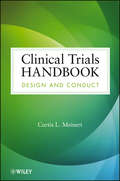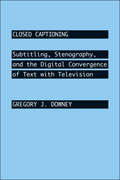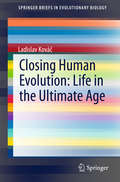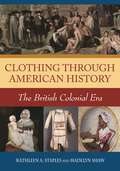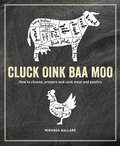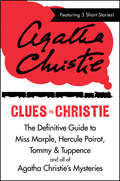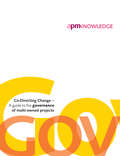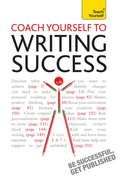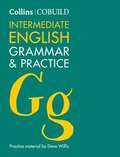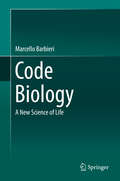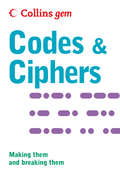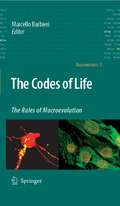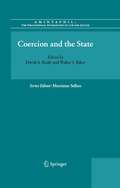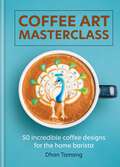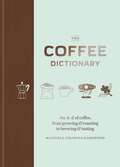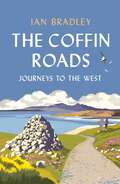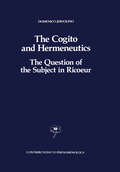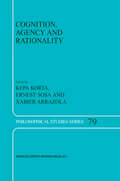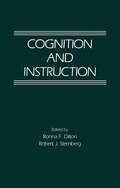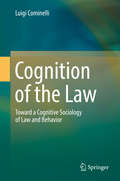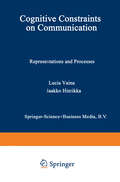- Table View
- List View
Clinical Trials Dictionary: Terminology and Usage Recommendations
by Curtis L. MeinertA thoroughly updated new edition of the essential reference on the design, practice, and analysis of clinical trials Clinical Trials Dictionary: Terminology and Usage Recommendations, Second Edition presents clear, precise, meticulously detailed entries on all aspects of modern-day clinical trials. Written and compiled by one of the world’s leading clinical trialists, this comprehensive volume incorporates areas of medicine, statistics, epidemiology, computer science, and bioethics—providing a treasure trove of key terms and ideas. This new edition continues to supply readers with the A–Z terminology needed to design, conduct, and analyze trials, introducing a vocabulary for the characterization and description of related features and activities. More than 300 new entries are now included, reflecting the current usage practices and conventions in the field, along with usage notes with recommendations on when to use the term in question. Detailed biographical notes highlight prominent historical figures and institutions in the field, and an extensive bibliography has been updated to provide readers with additional resources for further study. The most up-to-date work of its kind, Clinical Trials Dictionary, Second Edition is an essential reference for anyone who needs to report on, index, analyze, or assess the scientific strength and validity of clinical trials.
Clinical Trials Handbook: Design and Conduct
by Curtis L. MeinertA systematic approach to all aspects of designing and conducting clinical trials The success or failure of clinical trials hinges on hundreds of details that need to be developed, often under less than ideal conditions. Written by one of the world's leading trialists, Clinical Trials Handbook: Design and Conduct provides clinicians with a complete guide to designing, conducting, and evaluating clinical trials—teaching them how to simplify the process and avoid costly mistakes. The author draws on his extensive clinical trials experience to outline all steps employed in setting up and running clinical trials, from budgeting and fundraising to publishing the results. Along the way, practical advice is offered while also addressing a mix of logistical, ethical, psychological, behavioral, and administrative issues inherent to clinical trials. Topics of coverage include: Protocols for drug masking, controls, and treatment randomization Consent, enrollment, eligibility, and follow-up procedures Different types of sample size design and data collection and processing Working with study centers, research staff, and various committees Monitoring treatment effects and performance, and ensuring quality control Data analysis and access policies for study data and documents Clinical Trials Handbook is invaluable for practicing clinicians and trialists who would like to learn more about or improve their understanding of the design and execution of clinical trials. The book is also an excellent supplement for courses on clinical trials at the graduate level.
Clinical Trials Handbook: Design and Conduct
by Curtis L. MeinertA systematic approach to all aspects of designing and conducting clinical trials The success or failure of clinical trials hinges on hundreds of details that need to be developed, often under less than ideal conditions. Written by one of the world's leading trialists, Clinical Trials Handbook: Design and Conduct provides clinicians with a complete guide to designing, conducting, and evaluating clinical trials—teaching them how to simplify the process and avoid costly mistakes. The author draws on his extensive clinical trials experience to outline all steps employed in setting up and running clinical trials, from budgeting and fundraising to publishing the results. Along the way, practical advice is offered while also addressing a mix of logistical, ethical, psychological, behavioral, and administrative issues inherent to clinical trials. Topics of coverage include: Protocols for drug masking, controls, and treatment randomization Consent, enrollment, eligibility, and follow-up procedures Different types of sample size design and data collection and processing Working with study centers, research staff, and various committees Monitoring treatment effects and performance, and ensuring quality control Data analysis and access policies for study data and documents Clinical Trials Handbook is invaluable for practicing clinicians and trialists who would like to learn more about or improve their understanding of the design and execution of clinical trials. The book is also an excellent supplement for courses on clinical trials at the graduate level.
Closed Captioning: Subtitling, Stenography, and the Digital Convergence of Text with Television (Johns Hopkins Studies in the History of Technology)
by Gregory J. DowneyThis engaging study traces the development of closed captioning—a field that emerged in the 1970s and 1980s from decades-long developments in cinematic subtitling, courtroom stenography, and education for the deaf. Gregory J. Downey discusses how digital computers, coupled with human mental and physical skills, made live television captioning possible. Downey's survey includess the hidden information workers who mediate between live audiovisual action and the production of visual track and written records. His work examines communication technology, human geography, and the place of labor in a technologically complex and spatially fragmented world. Illustrating the ways in which technological development grows out of government regulation, education innovation, professional profit-seeking, and social activism, this interdisciplinary study combines insights from several fields, among them the history of technology, human geography, mass communication, and information studies.
Closing Human Evolution: Life in the Ultimate Age (SpringerBriefs in Evolutionary Biology)
by Ladislav KováčThis volume analyses the evolution of humankind by combining approaches from science and the arts. It offers a novel perspective on the evolution of life on Earth, based on a recent reformulation of the second law of thermodynamics in terms of the “maximum entropy production principle.” In essence, the Earth is but one of many “white holes” in the universe, where life functions as a specific arrangement for the rapid dissipation of energy gradients by generating self-organized structures. Evolution of life in the universe is a creative process of increasing complexity as a Bayesian ratchet of knowledge accumulation, advancing in an evolutionary maze characterized by myriad blind alleys. On Earth, the human species has progressed more than any other by creating artefacts that have become both agents and products of in our cumulative cultural evolution. Culture has dramatically enhanced the rate of dissipation of energy gradients. Extrapolating from the acceleration of cultural evolution suggests that humanity will reach the Civilization Singularity in the middle of the 21st century, a point in time at which the rate of changes, and hence their unpredictability and uncontrollability, will converge to infinity. Humankind has now entered the ultimate age, in which the exuberance and splendour of human feats may be metaphorically likened to fireworks.The author highlights a new role of scientists as intellectuals who can create “music for the fireworks” by analysing the consequences of the astounding dynamics in order to make the closing phase of human evolution a sublime one marked by minimal political and social tensions.
Clothing through American History: The British Colonial Era
by Kathleen A. Staples Madelyn C. ShawThis study of clothing during British colonial America examines items worn by the well-to-do as well as the working poor, the enslaved, and Native Americans, reconstructing their wardrobes across social, economic, racial, and geographic boundaries.Clothing through American History: The British Colonial Era presents, in six chapters, a description of all aspects of dress in British colonial America, including the social and historical background of British America, and covering men's, women's, and children's garments. The book shows how dress reflected and evolved with life in British colonial America as primitive settlements gave way to the growth of towns, cities, and manufacturing of the pre-Industrial Revolution.Readers will discover that just as in the present day, what people wore in colonial times represented an immediate, visual form of communication that often conveyed information about the real or intended social, economic, legal, ethnic, and religious status of the wearer. The authors have gleaned invaluable information from a wide breadth of primary source materials for all of the colonies: court documents and colonial legislation; diaries, personal journals, and business ledgers; wills and probate inventories; newspaper advertisements; paintings, prints, and drawings; and surviving authentic clothing worn in the colonies.
Clothing through American History: The British Colonial Era
by Kathleen A. Staples Madelyn C. ShawThis study of clothing during British colonial America examines items worn by the well-to-do as well as the working poor, the enslaved, and Native Americans, reconstructing their wardrobes across social, economic, racial, and geographic boundaries.Clothing through American History: The British Colonial Era presents, in six chapters, a description of all aspects of dress in British colonial America, including the social and historical background of British America, and covering men's, women's, and children's garments. The book shows how dress reflected and evolved with life in British colonial America as primitive settlements gave way to the growth of towns, cities, and manufacturing of the pre-Industrial Revolution.Readers will discover that just as in the present day, what people wore in colonial times represented an immediate, visual form of communication that often conveyed information about the real or intended social, economic, legal, ethnic, and religious status of the wearer. The authors have gleaned invaluable information from a wide breadth of primary source materials for all of the colonies: court documents and colonial legislation; diaries, personal journals, and business ledgers; wills and probate inventories; newspaper advertisements; paintings, prints, and drawings; and surviving authentic clothing worn in the colonies.
Cluck, Oink, Baa, Moo
by Miranda BallardA comprehensive guide to buying and cooking beef, lamb, pork, chicken, turkey and game featuring 90 delicious recipes to enjoy – from flash-fried steaks to slow-cooked pulled pork and everything in-between.
Clues to Christie: The Definitive Guide To Miss Marple, Hercule Poirot, Tommy And Tuppence And All Of Agatha Christie's Mysteries
by Agatha Christie John CurranThe ultimate introductory guide to Agatha Christie and her detectives, including stories featuring Hercule Poirot, Miss Marple, and Tommy & Tuppence.
Co-Directing Change
by APM Governance Specific Interest GroupMulti-owned projects are on the increase, as businesses and other organisations capitalise on their complementary resources while diluting risk exposure. Written by the APM Governance Specific Interest Group, this guide enables an organisation’s directors to question how well its shared projects are governed and to decide where and at what level action is needed. Readers of this publication may also be interested in Directing Change, Sponsoring Change and Directing Agile Change
Coach Yourself to Writing Success: Boost Motivation, Increase Creativity and Achieve Your Writing Goals (Teach Yourself)
by Bekki HillYou know how to woo publishers. You know how to write. But do you know how to overcome the things that prevent you being published? This book is the first personal coach for writers. If you write, whether professionally, for fun, or with dreams of doing both, it will help you to change your relationship with your writing, to be more motivated, to be more creative, less challenged and, ultimately, to be more successful. It will help you create strong strategies to ensure you succeed and will address such timeless writing challenges as writers' block, lack of time and even rejection.
COBUILD Intermediate English Grammar And Practice: B1-B2 (Collins COBUILD Grammar)
by Collins CobuildCode Biology: A New Science of Life
by Marcello BarbieriThis book is the study of all codes of life with the standard methods of science. The genetic code and the codes of culture have been known for a long time and represent the historical foundation of this book. What is really new in this field is the study of all codes that came after the genetic code and before the codes of culture. The existence of these organic codes, however, is not only a major experimental fact. It is one of those facts that have extraordinary theoretical implications. The first is that most events of macroevolution were associated with the origin of new organic codes, and this gives us a completely new reconstruction of the history of life. The second implication is that codes involve meaning and we need therefore to introduce in biology not only the concept of information but also the concept of biological meaning. The third theoretical implication comes from the fact that the organic codes have been highly conserved in evolution, which means that they are the greatest invariants of life. The study of the organic codes, in short, is bringing to light new mechanisms that have operated in the history of life and new fundamental concepts in biology.
The Codes of Life: The Rules of Macroevolution (Biosemiotics #1)
by Marcello BarbieriBuilding on a range of disciplines – from biology and anthropology to philosophy and linguistics – this book draws on the expertise of leading names in the study of organic, mental and cultural codes brought together by the emerging discipline of biosemiotics. The volume represents the first multi-authored attempt to deal with the range of codes relevant to life, and to reveal the ubiquitous role of coding mechanisms in both organic and mental evolution.
Coercion and the State (AMINTAPHIL: The Philosophical Foundations of Law and Justice #2)
by David A. Reidy Walter J. RikerA signal feature of legal and political institutions is that they exercise coercive power. The essays in this volume examine institutional coercion with the aim of trying to understand its nature, justification and limits. Included are essays that take a fresh look at perennial questions. Leading scholars from philosophy, political science and law examine these and related questions shedding new light on an apparently inescapable feature of political and legal life: Coercion.
Coffee Art Masterclass: 50 incredible coffee designs for the home barista
by Dhan TamangTake your coffee art to the next level with 50 spectacular-yet-simple latte art designs to impress family and friends. From the comfort of your own kitchen you can recreate great paintings, pour and etch stunning natural wonders, iconic buildings and fantastical creatures. No special equipment is needed and once you've mastered the basics a world of incredible coffee art awaits you.Coffee Art Masterclass includes next-level latte designs that everyone can achieve.
The Coffee Dictionary: An A-Z of coffee, from growing & roasting to brewing & tasting
by Maxwell Colonna-DashwoodAn A-Z compendium of everything you need to know about coffee, from a champion barista.Coffee is more popular than ever before - and more complex. The Coffee Dictionary is the coffee drinker's guide to the dizzying array of terms and techniques, equipment and varieties that go into creating the perfect cup. With hundreds of entries on everything from sourcing, growing and harvesting, to roasting, grinding and brewing, three-time UK champion barista and coffee expert Maxwell Colonna-Dashwood explains the key factors that impact the taste of your drink.Illustrated throughout and covering anything from country of origin, variety of bean and growing and harvesting techniques to roasting methods, brewing equipment, tasting notes - as well as the many different coffee-based drinks - The Coffee Dictionary is the final word on coffee.
The Coffin Roads: Journeys to the West
by Ian Bradley'Coffin roads' along which bodies were carried for burial are a marked feature of the landscape of the Scottish Highlands and islands – many are now popular walking and cycling routes. This book journeys along eight coffin roads to discover and explore the distinctive traditions, beliefs and practices around dying, death and mourning in the communities which created and used them.The result is a fascinating snapshot into place and culture. After more than a century when death was very much a taboo subject, this book argues that aspects of the distinctive West Highland and Hebridean way of death and approach to dying and mourning may have something helpful and important to offer to us today.
The Cogito and Hermeneutics: The Question of the Subject in Ricoeur (Contributions to Phenomenology #6)
by D. Jervolinoby Paul Ricoeur It is already a piece of good fortune to find oneself understood by a reader who is at once demanding and benevolent. It is an even greater fortune to be better understood by another than by one's own self. In effect, when I look back, I am rather struck by the discontinuity among my works, each of which takes on a specific problem and apparently has little more in common with its predecessor than the fact of having left an overflow of unanswered questions behind it as a residue. On the contrary, Domenico Jervolino's interpretation of my works, which extend over more than forty years, stresses their coherence, in spite of the gap in time between my present, soon to be issued work--Temps et Recit--and my first, Philosophie de la Volonte: Ie Volontaire et l'lnvolontaire. Our friend finds the principle of coherence first of all in the recurrence of a problem: the destiny of the idea of subjectivity, caught in the cross-fire between Nietzsche and Heidegger on one side and semiology, psychoanalysis and the critique of ideology on the other. He finds it likewise in the insistence on a method: the mediating role played by interpretation, mainly of texts, with regard to reflexion on self.
Cognition, Agency and Rationality: Proceedings of the Fifth International Colloquium on Cognitive Science (Philosophical Studies Series #79)
by XabierArrazola ErnestSosa KepaKortaAs usual, the Proceedings of the International Colloquium on Cognitive Science include leading-edge work by outstanding researchers in the field. This volume contains three kinds of papers corresponding to three of the main disciplines in cognitive science: philosophy, psychology, and artificial intelligence. The title - Cognition, Agency and Rationality - captures the main issues addressed by the papers. Of course, all are concerned with cognition, but some are especially centred on the very concept of rationality, while others focus on (multiple) agency. The diversity of their disciplinary origins and standpoints not only reflects the main topics and the range of different positions presented at ICCS-97, as well as demonstrating the richness, fruitfulness and diversity of research in cognitive science today.
Cognition and Instruction
by Ronna F. Dillon Robert J. SternbergCognition and Instruction focuses on the relationship of knowledge acquisition processes with instruction, including reading, writing, mathematics, curriculum design and reform, and reasoning. The selection first takes a look at the issues in cognitive psychology and instruction, reading, and writing. Discussions focus on the processes of knowledge acquisition, cognitive prescriptions for teaching, cognitive components of reading, instruction in reading, distinctive nature of higher order mental activity in written composition, and knowledge-transforming procedures within the general context of higher order skills. The publication also offers information on second language and mathematics. The text ponders on science, social studies, and art. Topics include psychological research related to curriculum design, science curriculum reform, curriculum and instructional components of social studies and social sciences, evidence for individual styles in young children, educational considerations, and concept of style. The text then examines music and reasoning. The selection is a valuable source of data for readers and cognitive psychologists pursuing research on the relationship of cognition and instruction. The most recent developments in cognitive psychologyUp-to-date literature reviewsChapter on training reasoningActive, renowned contributing authors
Cognition of the Law: Toward a Cognitive Sociology of Law and Behavior
by Luigi CominelliThis book’s basic hypothesis – which it proposes to test with a cognitive-sociological approach – is that legal behavior, like every form of human behavior, is directed and framed by biosocial constraints that are neither entirely genetic nor exclusively cultural. As such, from a sociological perspective the law can be seen as a super-meme, that is, as a biosocial constraint that develops only in complex societies. This super-meme theory, by highlighting a fundamental distinction between defensive and assertive biases, might explain the false contradiction between law as a static and historical phenomenon, and law as a dynamic and promotional element. Socio-legal scholars today have to face the challenge of pursuing a truly interdisciplinary approach, connecting all the fields that can contribute to building a modern theory of normative behavior and social action. Understanding and framing concepts such as rationality, emotion, or justice can help to overcome the significant divide between micro and macro sociological knowledge. Social scientists who are interested in the law must be able to master the epistemological discourses of different disciplines, and to produce fruitful syntheses and bridge-operations so as to understand the legal phenomenon from each different point of view. The book adopts four perspectives: sociological, psychological, biological-evolutionary and cognitive. All of them have the potential to be mutually integrated, and constitute that general social science that provides common ground for exchange. The goal is to arrive at a broad and integrated view of the socio-legal phenomenon, paving the way for a comprehensive theory of norm-oriented and norm-perceived actions.
Cognitive Aspects of Bilingualism
by Liliana Albertazzi Istvan KecskesThis work has a uniquely cognitive-functional perspective on bi-lingualism. This means that it makes a clear distinction between real world and projected world. Information conveyed by language must be about the projected world. Both the experimental results and the systematic claims in this volume call for a weak form of whorfianism. The authors examine too some relatively unexplored issues of bilingualism, such as, among others, gender systems in the bilingual mind, synergic concepts, and ontological categorization.
Cognitive Constraints on Communication: Representations and Processes (Studies in Linguistics and Philosophy #18)
by L. M. Vaina Jaakko HintikkaCommunication is one of the most challenging human phenomena, and the same is true of its paradigmatic verbal realization as a dialogue. Not only is communication crucial for virtually all interpersonal relations; dialogue is often seen as offering us also a paradigm for important intra-individual processes. The best known example is undoubtedly the idea of concep tualizing thinking as an internal dialogue, "inward dialogue carried on by the mind within itself without spoken sound", as Plato called it in the Sophist. At first, the study of communication seems to be too vaguely defmed to have much promise. It is up to us, so to speak, to decide what to say and how to say it. However, on eloser scrutiny, the process of communication is seen to be subject to various subtle constraints. They are due inter alia to the nature of the parties of the communicative act, and most importantly, to the properties of the language or other method of representation presupposed in that particuIar act of communication. It is therefore not surprising that in the study of communication as a cognitive process the critical issues revolve around the nature of the representations and the nature of the computations that create, maintain and interpret these representations. The term "repre sentation" as used here indicates a particular way of specifying information about a given subject.
